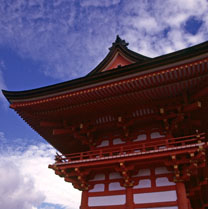|
With
a population closing in on 13 million, Tokyo
is one of world's mega-cities. Officially known as the Tokyo Metropolis,
it is not really a "city" at all, but is actually one
of the 47 Japanese prefectures. Tokyo is made up of 23 wards that
are each governed as separate cities. The vast sprawl surrounding
Tokyo proper is one of the most densely populated regions on earth.
Depending on your definition of "Greater Tokyo", 35 to
40 million people occupy Tokyo and its suburbs.
Formerly
known as Edo, it rose to prominence in the 17th century when the
Shogun, Tokugawa Ieyasu made it his base of operations. It functioned
as the Capital of the Edo government for 263 years before the Shogunate
was overthrown and the Imperial government restored. While it is
a modern city, resembling New York to some degree, it definitely
maintains a character all it's own with pockets of traditional Japanese
culture interspersed between Glass towers and neon signs. The city
is vast but easily tamed using the massive Tokyo subway and rail
network. Getting to our hotel from Narita airport was probably the
most trying travel experience in Tokyo and that only took an hour
or so by rail.
Initially,
I was not excited about Tokyo, preferring the history of Kyoto and
the scenery of Hakone. Tokyo was just the place we landed, but I
soon found myself longing for at least another day. There were far
more temples and shrines to study than I had envisioned and I thoroughly
enjoyed dodging forklifts at the Tsukiji Fish Market followed by
a cup of coffee in the surrounding food market. I often judge a
destination by the strength and quality of its coffee and Tokyo
scored well on this account. Most of all, I truly enjoyed just wandering,
gawking at the fashionistas in Harajuku, watching the signal change
at the worlds busiest intersection - Shibuya Crossing - or watching
a wedding ceremony (rehearsal)? at Meiji-Jingu.
Tokyo
turned out to have a certain charm. It is hard to escape the ever
present crush of humanity at peak hours in the business districts,
though it surprisingly quiet early in the morning and one can always
find a booth selling tempura or fish on a stick.
Hakone
is a town located inside Fuji-Hakone-Izu National Park. With many
natural hot springs and views of Mt. Fuji, the park is the most
visited national park in Japan. It's a half an hour from Tokyo by
shinkansen to Odawara station and then about 45 minutes on the Hakone-Tozan
scenic railway. We stayed in Miyanoshita at the Fujiya Hotel, a
beautiful historic hotel that reminded us of the Stanley in Stephen
Kings, "The Shining". Built in 1878, the hotel was the
first western-style resort hotel in Japan.
The
highlight of the park is a unique self guided tour called the Hakone
Round Course. It begins with a funicular railway that runs up the
mountain side and transfers to a ropeway (tram). The tram traverses
the mountain, then transfers to a boat ride across Lake Ashi. The
boat ride is pirate themed and a bit Disneyesque but quite entertaining
nonetheless. Unfortunately, weather did not cooperate and the views
were, well...wet. Still, we stayed in a grand old hotel, hot tubbed
in a bath heated with natural hot springs and wandered the autumn
leaves of a beautiful Japanese garden. Not too shabby. Other sites
in the area include the Open Air Museum, Hakone Jinja Shrine and
Great Boiling Valley.
When
one thinks of traditional Japan, Kyoto
is what one visualizes. Located in the Kansai region and originally
known as Heian-kyo, ("tranquility and peace capital"),
the city officially became the capital of Japan in the year 794.
The capital was moved to Heian-kyo from Tokyo to lessen the influence
of Buddhist clergy - somewhat ironic since ancient religious icons
are one of the primary tourist attractions of the region. In the
12th century, the name was changed to Kyoto which means literally
"Capital City". Kyoto remained the capital of Japan until
1869, when the seat of government was returned to Tokyo.
While
Kyoto has seen many fires, wars and natural disasters, it's historic
status spared it much of the devastation visited on other Japanese
cities by allied carpet bombing, during WW II. The city was originally
considered as a target for the atomic bomb but was dropped from
that list as well. As a result, the area is replete with examples
of various stages of Japanese culture. Ancient castles, temples
and shrines dot the landscape and the Kansai region has a large
number of UNESCO World Heritage Sites.
I enjoyed
Tokyo greatly and Hakone was beautiful but Kyoto is the reason to
go to Japan. Much of the city is like any western city (though it
appears there are height restrictions on buildings in central Kyoto)
but a walk through the Higashiyama district finds a hidden gem around
virtually every corner. Restaurants and entertainment in Gion, shopping
at the Teramachi Arcade and a walk through the Nishiki Food Market
(Who doesn't love fish on a stick) are memories I'll keep for a
lifetime. I hope to return to Japan. I'll visit the National Parks
in the North, the ancient capital of Nara and the beaches of Okinawa
but I will most definitely return to Kyoto.
|

